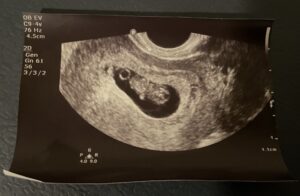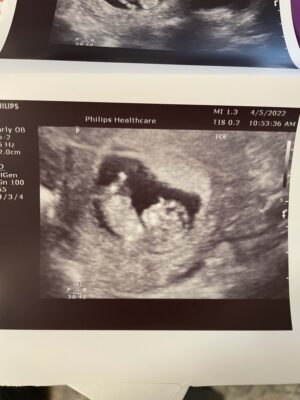Faith’s prenatal care began at Walter Reed Army Medical Center. I can’t begin to describe how excited I was to see baby and hear the heartbeat on ultrasound. I was 9 weeks along during the first ultrasound, and everything went smoothly. Baby was so small and looked like a little gummy bear!
I was 11 weeks along for the second OB appointment. As the midwife scanned my belly, we saw baby dancing around. She moved much more than I expected and had so much energy! When we heard baby’s heartbeat, I breathed a sigh of relief. At this point, I was still terrified of miscarrying and felt a wave of anxiety dissipate as I heard that sweet “whoosh-whoosh” of the heartbeat.
We opted to have Non-Invasive Prenatal Testing (NIPT). This test uses my blood to determine baby’s risk of chromosomal abnormalities, such as Down Syndrome, Turner Syndrome, and Trisomies 13 and 18. NIPT also tells you the sex of the baby, and to be honest, we opted for NIPT because we wanted to know the baby’s gender more than we wanted to know the chromosomal abnormality risk. At 37 years old, I was considered a “geriatric mother,” but we figured I was healthy, and the risk of Down Syndrome was still less than 1%. We never imagined screening positive for any of the other incredibly rare chromosomal abnormalities!
My midwife told us to expect the results in 7-10 days. 10 days came and went without any results. After over 2 weeks of waiting, I called my doctor’s office to see what was taking so long. The nurse who answered told me these tests take more than 2 weeks to process, so I should just keep waiting. I insisted on speaking with my midwife. The nurse said the midwife wasn’t available but would call me back.
I’m glad I insisted because when the midwife called, she told me the lab lost my blood sample, and I would have to re-do the test. So, I had my blood drawn a second time.
While we awaited our results, I had the opportunity to speak at the Smithsonian’s She Can STEAM Camp graduation. This is an aviation summer camp for young girls, and as an advocate for increasing the number of female aviators, I was thrilled at the opportunity!
Whenever I speak about aviation, the first question I ask the audience is “What do you think makes a good pilot?” People shout out answers such as, “They can land the plane,” or “They’re good at math!” After I solicit answers from the crowd, I continue my talk and tell them of my experience as a pilot.
At the end of the talk, I always give my answer to the “What makes a good pilot?” question. And that answer is: “I think a good pilot is good at making decisions.” In aviation, and especially military aviation, we must make decisions where the answer isn’t always black and white. I gave the example of “Reach 871,” a C-17 that carried over 800 refugees out of Afghanistan, even though C-17s were not designed to carry that many people. The pilot had to decide if he would take more people than his plane was designed to carry, or leave the people in Afghanistan. It’s a tough decision, with no textbook answer. In this case, the pilot chose to evacuate the refugees and received the Distinguished Flying Cross for his decision.
I mention this talk because we had to make many of these types of decisions for Faith. Here are some questions doctors asked us:
- Do you want to terminate the pregnancy?
- Do you want a c-section if Faith goes into fetal distress?
- Do you want CPR for the baby?
- How much medical intervention do you want her to receive?
- What do you want the end of her life to look like?
- Do you want to remove life support?
These questions had no right or wrong answers and were very difficult for us to think about, let alone answer. But, we NEEDED to make these types of decisions for Faith.
After I gave my talk to the summer camp graduates, Josh and I had lunch at Red Robin. As Josh paid our bill, I checked my email and saw an email from Labcorp. I opened it. The results read: “Female.” I was ecstatic! I really wanted a baby girl!
I continued reading and came across the words “Abnormal” and “Patau’s Syndrome, Trisomy 13.” I had no idea what Trisomy 13 was. However, it was Sunday. Our doctor’s office was closed, and I had to wait until the next day to get some answers. I spent the rest of the day researching NIPT accuracy and Trisomy 13.
The next morning, I called my doctor’s office, but the nurse who answered said they didn’t receive our lab results. I asked the nurse a few questions about the test, and she attempted to answer all my questions. But, in hindsight, I shouldn’t have asked her anything. She did not know much about positive test results. Not only did she give me incorrect information about the test, but she also said to me “Knock on wood, but I never had a positive test be incorrect.”
I’m not sure why, but I found those words incredibly insincere. Here I was in distress with no clue on how to interpret my lab, and here she was telling me over the phone that my baby was going to die.
I had to call the lab and tell them to send the results to my doctor. The whole process of getting the NIPT was a NIGHTMARE. Thankfully, I was given the option to seek care from a civilian OBGYN and took it!
Eventually, the genetic counselor called to discuss the lab results. She explained that we had a 22.9% chance that the positive test result was accurate. Which meant we had a 77.1% chance our baby did NOT have Trisomy 13! This was a little bit of a relief, but we were still anxious as we awaited our Maternal Fetal Medicine appointment.
Looking back at everything, I’m glad the lab lost our first results. I’m thankful I got to prepare and give my talk at the summer camp. I needed that talk not for the graduates, but for myself. To remind myself that we don’t always choose our circumstances, but we can always choose our actions. I needed to remind myself that I know how to make good decisions, and that I am the best decision maker for my baby.
decisions, and that I am the best decision maker for my baby.
